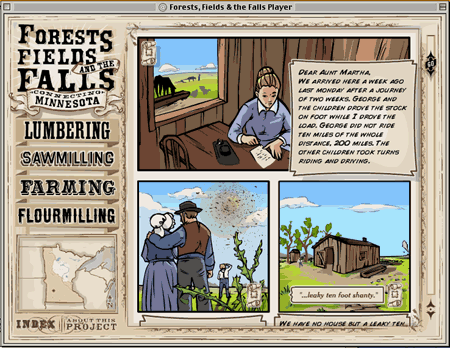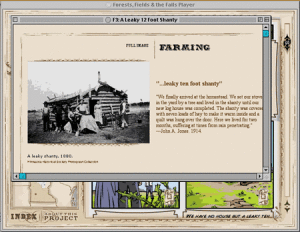Telling Stories Out of School: Primary sources and the Internet

Recent issues of the Common School have spoken of the vibrancy of primary sources as a means of engaging students in the subject of history: making the student be a historian, not simply a hard drive. Their use teaches students to recognize authorship and point-of-view in interpretation, to understand that information about the past is fragmentary and sometimes contradictory, and to learn the steps of historical inquiry.
But there is something missing in the idea that primary sources alone are engaging, meaningful tools for learning. A short, true story:
The Minnesota Historical Society is home to thousands and thousands of documents, the State Archives, and tens of thousands of cubic feet of objects. These are all primary sources. Many (but by no means all) of these items are available online, which means that they are easily accessible without a trip to St. Paul and hours in the old card catalogs. These include a set of letters, scanned and also transcribed, from brothers fighting in the Civil War; and over 180,000 photographs in a searchable database. Still, the society received an exasperated e-mail from a parent trying to help their child with homework: “the Minnesota Historical Society [W]eb page . . . [has] nothing of substance to help with an assignment on the history of Minnesota.”
Why was this parent so frustrated when the site is full of primary sources? Because those sources too often had no context. I submit that primary sources are most valuable in learning if they have a personal meaning to the audience, either one they bring to the source or one that they gain through context and art, such as storytelling or interpretation. Hardly a radical concept, but when it comes to the Internet it seems to be all too much of a new idea.
Enter “Forests, Fields, and the Falls,” a primary-source-based story of Minnesota’s past that was created for school and informal audiences using the unique strengths of the Web. In it, the letters or reminiscences of four everyday people from the state’s earlier years are edited into sequential art (graphic-novel style) stories. In effect, each historic person is telling their own story to a modern audience; the four stories combined make a larger point about Minnesota, stated up front in an introductory movie.
In each story there are little icons indicating a second layer of information. If you are in the frame of the farming story showing the Carpenter family’s shack of a house with Mary Carpenter’s description of their “leaky ten foot shanty,” mouse over the boxy icon and see a caption indicating that if you click, you will be able to find more about the shanty. Click and you open a new window with a historic photo of just such a house plus a quotation from another settler describing his own shanty: two primary sources that reinforce the single idea from our main story. Click on the icons in other frames and you might get a document, a map, a recipe, an object, etc. In addition, you can access the complete transcripts of the sources from which each story is drawn.
Throughout the entire site there are probably less than five hundred words written by the curator (excepting photo credits and identifying captions). This is a story told by and through primary sources. And the collection of sources is put in context through the larger story. So the photo of a funny-looking machine makes more sense because we see it in the illustrated context of its use. In the mind of the visitor there is then a cubby hole created in which to place the information about the thresher, or the cork boot, or the log stamp; it is not just data from a collections database but detail for a factual narrative. And that makes it more intelligible, meaningful, and memorable.
At least that’s the theory.
This site is an experiment. We know that most people currently use the Internet for information gathering. They do not expect to spend time being engaged in a story (unless they are gaming). For the information gatherers, they may prefer something more database-like because they know what they are after and want to just get it as quickly as possible. There is some research to suggest that our collection of TimePieces is just as successful as “Forests, Fields, and the Falls.”
That said, we have received a laudatory e-mail about our online comic book from someone at a marketing firm (a marketing firm!) titled, “Bravo!” He applauds the use of Flash and the site structure, blah, blah, blah. Most significantly, he concludes “I’m not from Minnesota, and to be honest, never thought twice about Minnesota’s history. Thanks for the education and the great [W]eb experience!” Clearly, he had no intention of getting hooked, but he was. And he believes that he learned something.
That glowing e-mail aside, until computers reside in the living room and people think of the Web as a source of learning and entertainment, our primary audience is necessarily in the classroom. When teachers tell their classes to explore the site, or when they assign a task around the site, students will take the time to use it. And here we have little information, though what we know suggests some success.
A professor of American history intends to use the site with her students mostly because of its collection of sources (the hundred-plus pages of Mary Carpenter’s letters, for instance, are an especially rich source but were not previously well known because they had not been transcribed). As an added bonus, she believes that it is easy to navigate, easy to read, and that her students will appreciate the illustrations. She also states, “I plan to direct people–students, other teachers of Minnesota history, Minnesota history buffs, Minnesotans–to the site, knowing that they will leave the site with a fuller, deeper, and more complex understanding of the state’s past.”
I have also talked with a fourth-grade teacher who used the site in his classroom. He noted that the kids loved the site, but that they did not seem to read the illustrated story. Instead, they spent their time with the pages of primary sources. I have to admit that I am a little disappointed the students are not absorbed by the narrative, but I am happily surprised that they are interested in the real meat of the matter: historic photos, quotes, and documents. This does not mean, however, that the story is irrelevant. An advantage of the comic-book style is that even if one does not read it, just scanning the illustrations to find the icons gives the visitor a sense of context.
The launch page for the site also links to ideas for classroom activities. Some of these activities take advantage of the illustrated story (e.g., a scavenger hunt or looking for hints of connections between the stories), some work off the main message (e.g., mapping or making connections), but others go straight to the issue of primary sources and our use of them. I am particularly interested in what students will find when they “Identify Point of View” of the main narrative sources or when they take the suggestion to read some of Mary Carpenter’s letters and edit them differently. These are challenging concepts for any student and a particular advantage of primary sources and the Web’s ability to layer from the abridged story to the unedited original source.
The question of success raises one of the difficulties for a Web-based informal educator. We can visit a few schools to see how the site is being used and we can receive kudos or slaps in the face by e-mail, but unless we build quizzes into the site (and since this is a museum site, where informal is a key word, quizzes are pretty much antithetical) we do not really know how it is being used or the meaning people are making. To a large extent we have to rely on what exhibit staff have learned over many years of trial and error, observation, and audience research. In particular: museums are about real things, primary sources. As such, people have a higher level of trust in the authenticity of something in and from a museum. Additionally, exhibits comprised of primary sources in static cases (with labels like “Shirt, 1873–donated by the Brown Family”) hold very little meaning for most people. Either visitors bring a context themselves or they need a context of some sort in which to put the object or document. If they bring a context, they can be said to be piecing together an understandable narrative in their head. When educators (whether exhibit curators, live docents, or teachers) supply the context, they are interpreting–telling a story.
For the most part, the Web has not yet learned this lesson. Sites are too often just advertising brochures or databases; throwbacks to the old days of boring exhibits. But the value of an artfully presented story (not necessarily one as linear as “Forests, Fields, and the Falls”) is as universal as the value of primary sources. Apart from each other, story and sources are weakened; together, they make history an engaging, active, and mind-altering endeavor.
Further Reading:
See Adam Bickford, “This Isn’t History, This Is My Life: The Minnesota Historical Society Focus Groups,” Minnesota Historical Society, 1996; John H. Falk and Lynn D. Dierking, Learning from Museums: Visitor Experiences and the Making of Meaning (Walnut Creek, Calif., 2000); and Roy Rozenzweig and David Thelen, The Presence of the Past: Popular Uses of History in American Life (New York, 1998). Special thanks to Maureen Otwell and Jennifer Lanning of the Minnesota Historical Society, who reviewed this article. If there is anything seriously wrong in it, it is their fault for not catching it. For everything that is correct, I accept full credit. “Forests, Fields, and the Falls” was developed by the Minnesota Historical Society with funding from the Institute for Museum and Library Services (IMLS). All engineering, illustration, and navigation by Invioni.
This article originally appeared in issue 4.3 (April, 2004).
Steve Boyd-Smith has developed interpretive exhibits for more than a decade and was project lead on “Forests, Fields, and the Falls” as curator of online interpretive projects at the Minnesota Historical Society. He encourages discussion on this topic at the Common-Place forum and welcomes e-mails at steve@itellstories.net.

